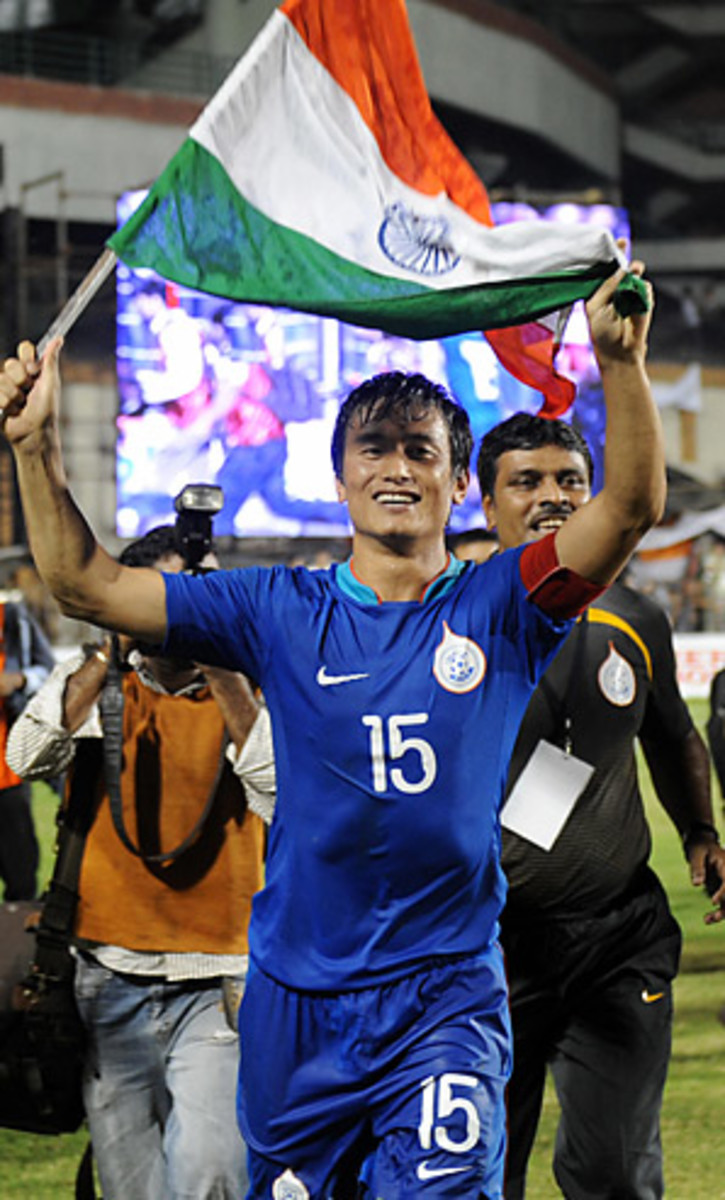With modest expectations, India preps for rare Asia Cup appearance
It sounds easy in comparison. If Bob Houghton could take Malmo -- a team made up of players who all hailed from in or around the Swedish city with a 300,000 population -- to the final of the 1979 European Cup, then making sure that India, the second-most-populous nation in the world, manages a single point from three Asian Cup games in January should be simple.
It won't be. India is ranked 138th in the world and in the winter heat of Qatar will face three of Asia's five top-ranked teams: Australia, South Korea and Bahrain. It was the toughest group imaginable as the Bhangra Boys prepare for their first appearance at the quadrennial competition since 1984.
Seeing stars such as Sunil Chhetri and Bhaichung Bhutia take on the likes of Park Ji-sung of Manchester United and Everton's Tim Cahill, if such players are released by their clubs, should put soccer firmly in the middle of the Indian sporting agenda for at least a week or two. It will be a welcome boost. Football is growing in popularity in India, but the fact that much of the coverage reflects the middle class's appetite for the more glamorous European game would be less frustrating if the I-League was not still struggling to establish a foothold in a sporting landscape dominated by cricket.
You may not get that impression if you attended the Kolkata Derby with 100,000 others to see East Bengal take on Mohun Bagan, but these pockets of Bengal, Goa, Kerala and parts of the northeast largely make up India in a soccer sense. Mumbai lost one of its three clubs at the end of last season as Mahindra United folded simply because financial backer Mahindra Group grew tired of investing in a team that few watched, though the company has promised to invest at a grass-roots level. That would be welcome, but even the opposite end of spectrum has struggled for attention in the past.
"Before I went there in 2006, there was very little interest in the national team, little work done and few games played," Houghton told SI.com as he prepared his team for a warmup match with Thailand in Bangkok. "When I got there, it had been a long time since we won a game and now we have changed that. We have been careful about who we played to get some confidence and some belief and get some enjoyment of playing for the national team."
The high point came at the 2008 AFC Challenge Cup when India won Asia's competition for second-tier teams and received a place at the main event as a reward. Central powers such as Turkmenistan, Afghanistan and Tajikistan are spirited but are far behind global players such as Australia and South Korea. It is a leap in standards that could take Indian football flying to the next level or leave it lying flat on its face.
"It depends which way you look at it," said Houghton, who, despite spending the majority of his 40 years of coaching overseas, including a season with the Colorado Rapids in 1996, still sounds like he has never left England. "It has already energized the nation. We have come off a two-month training camp in Portugal because we qualified for the Asian Cup. Because facilities in India are poor and the standard of football is poor, the federation wants the national team to have the best possible chance. What that will do, it will raise expectations. I don't know what is realistic.
"There is a view that it will be good for Indian football as it will put ourselves in the spotlight and there will be a lot of interest and we will play against teams that have just played in the World Cup. Or you know it will show people where we really are and that might set the game back. We really are in the infancy of trying to become a football country."
Even so, there is a fair amount of history in India. The country boasts the third-oldest cup competition in the world. The Durand Cup was started in 1888 by Mortimer Durand, another well-traveled Brit who also gave his name to the line that acts as a border between Afghanistan and modern-day Pakistan. Houghton treads a finer line, trying to promote the game in the country without raising false hopes. At the game between India and Thailand in Bangkok, an Indian journalist asked me what Houghton really thinks, believing that the Englishman doesn't always tell the truth when dealing with the local media. Houghton admits as much.
"I can't be honest at all," he said. "A coach has to talk to his own players and when you are talking to the media, you are talking to your own players -- that's the bottom line. If I wanted to take that tack and explain to the media that, 'Look, we have very little chance and we'll be lucky if we don't get walloped,' if you say that, it doesn't help you after you have played and done badly as they are still going to slaughter you. What it does is, it tells the players before they start that the coach doesn't fancy their chances."
Nobody fancies India's chances of progressing out of the group in Qatar in January, but if the team can compete with the likes of Australia and Korea, and perhaps even collect a point along the way, then for Houghton, that would be an achievement to rank alongside that run to the European Cup final 31 years ago.






